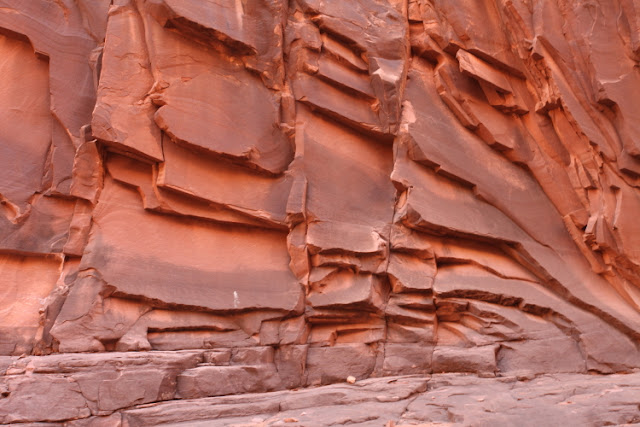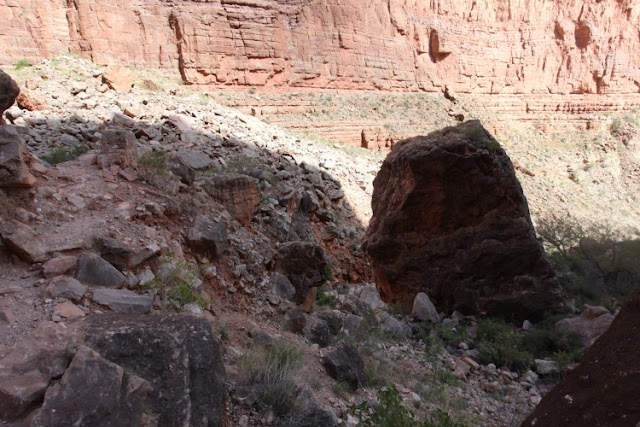Each year, I lead a trip for the Grand Canyon Field Institute for 10-days of rafting and exploring the Colorado River. We use the outfitter Arizona Raft Adventures (AzRA). On this years trip 14 lucky passengers experienced the wonder and awe of the Grand Canyon by boat.
I have another rafting trip scheduled next year from July 15 to 21. Leave a comment below if you would like to join in on the experience.
Our first stop on this trip was across from the boat ramp at Lees Ferry (background). Here we could see the tilted Mesozoic strata that sits on top of Grand Canyon's rocks.
The reason for the stop was to look at a huge and beautifully preserved petrified log within the Shinarump Conglomerate Member of the Chinle Formation.
The Vermilion Cliffs rise above the Kaibab Limestone, the first of Grand Canyon's many rock layers.
At River Mile 4, the Coconino Sandstone crops out sandwiched between the overlying Toroweap Formation and the underlying red Hermit Formation. In these northern exposures, the Coconino is only about 40-feet thick but will thicken to the south near Desert View to over 400 feet.
Ten Mile Rock is an obvious feature standing in the river. It is a remnant slab of the Coconino Sandstone that is likely part of a much larger debris field. It would be virtually impossible for this slab to land individually in this upright position. The Colorado is constantly removing obstacles in its path.
Which way does the river go? This is looking south to the junction of the Colorado and Soap Creek. On these trips, I always ask the question and the answers are generally 50-50, right or left. One of these canyons is a tributary of the Colorado that comes into the master stream pointed in what is now the upstream direction. Numerous side streams enter the Colorado in this fashion in Marble Canyon, suggesting that this part of the system might have previously flowed in the opposite direction (north).
Intriguing to say the least. You'll have to come along on a trip to find out the answer!
These cross-beds are within the Permian Esplanade Sandstone and have been sculpted by higher flows on the Colorado.
The intersection of cross-bedding and exfoliation fractures
Although it appears as perhaps only three rock units in this view, there are actually five formations exposed at about river mile 15 - from the top, Kaibab Limestone, Toroweap Formation and Coconino Sandstone make up the white cliff, with a red slope of the Hermit Formation and red cliffs in the Esplanade Sandstone.
Approaching the Boulder Narrows, another rockfall remnant in the middle of the Colorado River
Our first hike was in North Canyon. This is a typical view of a Grand Canyon hike - some scrambling around boulders but nothing really undoable.
Lush datura plant growing in North Canyon
More cross-bedding and exfoliation planes intersecting in North Canyon
Note the scale of the exfoliation in these canyon walls
This view downstream in North Canyon from the reflecting pool shows the evidence for how the exfoliation formed. Before the canyon was cut, all of these rocks were held in place by the pressure of surrounding rocks. As the canyon was excavated, these confining pressures were removed and the rocks "popped" outwards parallel to the canyons' walls and floor. Notice how the exfoliation planes are parallel to the walls and floor of the canyon.
This is an ancient river channel filled with conglomerate in the Supai "Formation." I call these channel forms, "smiley faces." I am a proponent of changing the term Supai Group (with four formations) back to a single formation with four members. This is a much more convenient and easier to use classification.
Back on the river, the Redwall Limestone is the next unit to appear from beneath the river. Note how ordinary it looks here.
But soon it takes on its massive appearance as the river slices deeper into it
The Muav Limestone is at river level now as we approach the Triple Alcoves and Saddle Canyon
Near the mouth of Saddle Canyon
Hiking up into the wonderland of Saddle Canyon. Curiously, the trail does not follow the creek bed but rather climbs on the south slope far above the bed of the creek.
Attaining the highest spot on the trail reveals the reason for the long detour - a massive cliff failure (landslide or rockfall) is still blocking the channel such that a dam is constructed across the stream bed. Saddle Creek is busy removing this obstacle but it will still take some time to return to its "normal" gradient.
Behind the dam is a valley filled with sediment, allowing the growth of a profusion of plant life
The "final" falls within the Muav Limestone
Our group at Saddle Falls
Looking downstream to the mouth of the Little Colorado River. The main channel of the Big Colorado River is barely noticeable to the far right. It appears that the course of the LCR and the Colorado were once linked here, with some kind of a capture or spillover event creating the main channel to the right. All of this would have occurred high up in the strata and not at present river levels.
The beautiful waters of the Little Colorado River. This is absolutely no place for a tramway or restaurant in the bottom of the Grand Canyon. Support www.savetheconfluence.com.
Near Tanner Rapids, these barrel cactus thrive below Comanche Point on the East Rim and the Palisades of the Desert
The Dox Formation is a MesoProterozoic nearshore deposit of sandstone and mudstone. The mudstone here at Rattlesnake Camp, sandwiched between two thin sandstone beds, looked like recent river mud but is actually about 1.1 billion years old. This completes Part 1 of the trip to Phantom Ranch.





























No comments:
Post a Comment
If your comment will not post, email me with the problem.